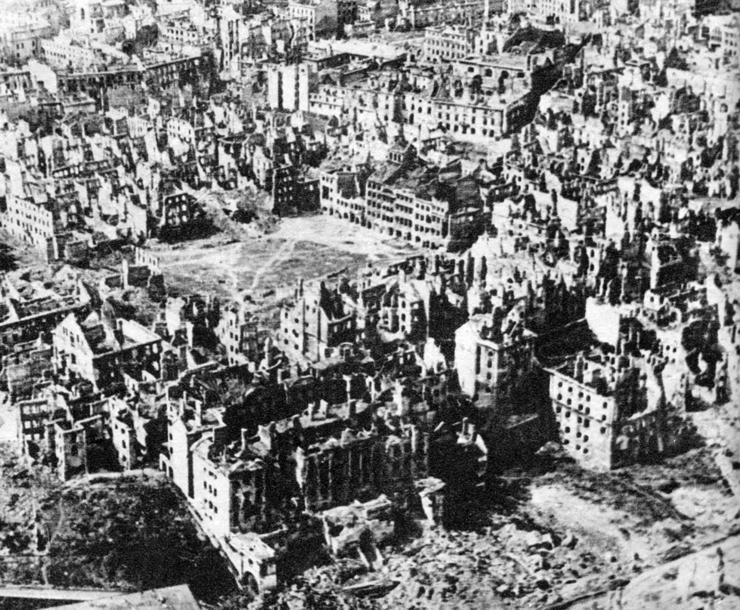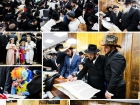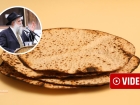Rosh Hashana Under Fire in Warsaw
When WWII broke out in Elul 5699 (1939), the Rebbe Rayatz was living in Otvotsk, a suburb of Poland’s capital. The intense bombardment by the Luftwaffe (the Nazi air force) prompted the Rebbe and his family to flee to Warsaw in the hope that it might be safer there. The Rosh Hashana of that first year of the new century was a fateful one and was observed in between running from one bomb shelter to another • A detailed account of Rosh Hashana 5700 in Lubavitch • By Beis Moshiach Magazine • Full Article
By Chaim Bruk, Beis Moshiach
Otvotsk. Friday 17 Elul 5699/1939. The talmidim of Yeshivas Tomchei Tmimim in Otvotsk (a resort town near Warsaw, capital of Poland) woke up to the terrifying sound of bombing.
Only a few hours passed when they learned that Germany had invaded Poland without warning. That was the outbreak of World War II, a war which engulfed the lives of the entire Europe in intense chaos. Fear and worry reigned. The thought, “Who knows what tomorrow will bring?” raced through minds unceasingly.
A short time after the German occupation of Poland, the yeshiva was closed and the talmidim dispersed as the hanhala told them to do.
The frightened talmidim asked the Rebbe Rayatz, who was in Otvotsk at the time what to do. He said whoever could leave Poland should do so. The Rebbe told the six talmidim who had American citizenship to go to nearby Latvia and continue homeward from there. He advised other talmidim to try and reach Vilna in Lithuania.
THE REBBE FLEES TO WARSAW
The Rebbe left Otvotsk for Warsaw for the purpose of continuing from there to Latvia. The road to Warsaw was difficult as it was strewn with dead horses and charred houses. The German air force bombed the highway leading to the burning capital, attempting to hit civilians who were trying to flee.
The Rebbe miraculously arrived in Warsaw where he stayed in the home of one of distinguished Chassidim, R’ Shneur Zalman Shmotkin. From there he helped other talmidim to escape to neutral countries.
Many talmidim left the city on foot after the train station was bombed unceasingly by the Germans. Interestingly, the border with Lithuania was closed only at the beginning of 5700. Before then, many tmimim were able to escape to Vilna. The Rebbe Rayatz, who found it hard to walk long distances, remained in Warsaw.
On 28 Elul, two days before Rosh Hashana, there was a heavy bombing raid over the area where the Rebbe lived and the Rebbe went down into the bomb shelter. It was a small alcove meant for barely twenty people and yet forty people squeezed in; the crush was intolerable. They were all frantic with worry and they tried to draw consolation and bitachon from the Rebbe.
It was under these circumstances that they began preparing for Rosh Hashana 5700/1939.
TREACHEROUS JOURNEY TO THE REBBE
R’ Yosef Wineberg was a talmid in the yeshiva in Otvotsk. He too returned home.
“After a few days at my parents’ home, I told my mother that this wasn’t for me. I wanted to be with the Rebbe.”
The young tamim left, somehow, in the direction of Warsaw. It was a real challenge considering the nonstop bombing by the Germans but the young man’s powerful desire to see the Rebbe, who was his entire life, was the image he kept in his mind’s eye and which helped him overcome all the difficulties and danger.
On Rosh Hashana 5700, he found himself with the Rebbe.
That Rosh Hashana, there were hardly any Chassidim with the Rebbe. Despite this, the Rebbe Rayatz conducted himself as he did every year, and even asked the Chassidim who crowded into his apartment to daven from the depths of the heart and with a lot of feeling.
R’ Wineberg described what he experienced at the Rebbe that fateful Rosh Hashana, as the tefillos took place under fire:
“The Nazis ym’s, knew this wasn’t an ordinary day for the Jews and looked for ways to torment them in any way possible. Among other things, they dropped bombs in areas where the Jews lived in Warsaw.”



Shelling by the Germans
“WHO WILL LIVE AND WHO WILL DIE”
“In the middle of the davening, as we were immersed in davening with deep feeling, massive bombing of the Jewish area began. From every side the bombing could be heard and the danger was palpable. The words, “who will live and who will die, who at his designated time and who not at his designated time” were real to us.
“The gabbai asked the Rebbe that they leave that place and look for somewhere to hide until the bombing stopped. At first the Rebbe refused and wanted to continue the davening as usual but the bombing intensified until there was no choice. We left the building with the Rebbe and hid until the bombing stopped.
“I remember that when we returned with the Rebbe to the apartment where we had been davening, a frightening sight met our eyes. The building across from it had collapsed. That sight was enough to demonstrate to us the big miracle that occurred for us. The truth is that it was only after some time that we were able to make that observation while at the time, fear overcame us. We didn’t even have the time to think about it.
“At that time, everything was murky and it was before we realized the horrors that were about to occur in this war. But the Rebbe saw what we did not know and already then he urged us to use every moment to recite Tehillim and to ask for the salvation of the klal.
“It was was a historic Rosh Hashana. The great inspiration and warmth of tefilla with the Rebbe were special. There was no lack of what to pray for, but what was missing was yishuv ha’daas (tranquility of mind). It was hard to impossible to maintain one’s concentration and calmness during those difficult, uncertain times.
“The amazing thing is that everything stopped at the Rebbe’s threshold. With the Rebbe there was a different feeling, as though the war was taking place elsewhere. The feeling was that of the days of light in Lubavitch. Although the number of Chassidim was very small, since most of them were not able to come and even those who lived close by had to remain with their families, the inspiration was very great.
“The Rebbe’s tefilla which was said slowly and movingly, and the Rebbe’s fiery face, infused all of us with a burning holy passion. Even that Rosh Hashana, despite the great fright, the Rebbe stood in his place and his davening took three hours with awesome weeping and tremendous inspiration. This sight is unforgettable to me even more than seventy years later.”
R’ Wineberg said that the following Rosh Hashana, 5701, he was unable to be with the Rebbe Rayatz, since the Rebbe was already in America and davening in the new Beis Medrash at 770 Eastern Parkway. However, in Vilna where he was at the time, he felt the Rebbe’s holy image accompanying him ever since those tefillos of Rosh Hashana, until he was able to leave, from darkness to light, and be saved from the terrors of war.
ONLY A SMALL PART OF THE TRAVAILS
Five months later, Purim 5700/1940, the Rebbe Rayatz described a bit of the events of those terrifying days:
“The twenty-seven terrifying days of war in Warsaw – 17 Elul 5799 – 12 Tishrei 5700; and the eighty-one – 14 Tishrei – 4 Teves 5700 – days of cruelty and fear of death that followed, do not allow me to return to myself. The bitter plight of our brothers and sisters and the terrible fear that envelopes me as I contemplate the horrors of the plot of Haman, give me no rest and I cry out: Jews of America of all groups and factions, save your brothers and sisters immediately!
“… As I sit now at the Purim meal, I live in spirit together with Jews and Anash and especially the talmidim of Tomchei Tmimim who remained there, and the essence of my soul calls out to you and to every Jew: Save them, save them!
“Knowing the strength of simple faith, bitachon and hope that Jews and Anash in general have, and bnei Torah and talmidim of Tomchei Tmimim in particular, I am sure that even those who dwell in the land of the shadow of death, who hide in cellars and ruins, also want to rejoice with the joy of Purim but under their circumstances this is not at all realistic. May Hashem have mercy and bestow salvation on Klal Yisrael.”
The Rebbe went on to describe the great difficulty that he experienced during those Yomim Noraim:
“In the present war in Poland, the situation is different. Children, women, old and sick people are all on the front lines, since the front was within the cities. The city where women, children, aged and the sick were bombed by high explosive and incendiary bombs. Thousands of people were buried under their collapsed homes within seconds.
“Jewish poverty in Poland was tremendous and felt in in every aspect of life, and above all the question of housing as all the Jewish areas in Warsaw were crowded. During the critical days of the war it happened that within a few seconds a building of several stories collapsed and all who lived in it, including children, women, old and sick, were burned or buried alive under the rubble. After the bombing they found in the streets of the city the bodies of people blown to bits mingled with the dead bodies of, l’havdil, horses and dogs. Human limbs were strewn in the streets. That was only a small part of the bitter fate that we endured during the war in Poland.”
GERMAN SOLDIERS SEARCH FOR THE REBBE
Getting back to Rosh Hashana 5700. Starting from the bombing on Rosh Hashana until after the holy day of Yom Kippur, the Rebbe went with a handful of Chassidim from house to house and from courtyard to courtyard, fleeing the nonstop bombing. Danger was close and palpable.
“Concurrently, during those days, German intelligence officers combed the streets of Warsaw looking for the Rebbe. The Chassidim, who feared what the Germans might do, realized they had to hide the Rebbe and so, hardly anyone knew where the Rebbe was which is why I also barely saw the Rebbe again,” said R’ Wineberg.
At a certain point, German soldiers knocked at the door of the Gurary family where the Rebbe was staying and asked to see the Lubavitcher Rebbe. They replied, “We don’t know who the Rebbe is.” A terrible fear took hold of the Rebbe’s family and the Gurarys; they thought the Nazis had discovered where the Rebbe was staying and wanted to harm him, G-d forbid.
But no. They were soldiers of the officer Ernst Bloch who wanted to save the Rebbe Rayatz. It was Admiral Wilhelm Canaris of German military intelligence who led the rescue campaign. A message arriving from the United States to the Rebbe’s household clarified that the purpose of the search was to rescue the Rebbe. The Rebbe’s household was relieved.
The Rebbe made his going conditional on twenty Chassidim joining him. Having no choice, the German soldiers agreed.
The Rebbe traveled with Officer Bloch until Berlin where the group was given over to the Latvian embassy. From there, the Rebbe continued to Riga where he arrived on 5 Teves 5700. The Rebbe sailed from Riga via Stockholm until New York.
THE REBBE’S TEARS
As mentioned, by Rosh Hashana 5701 the Rebbe was in New York. That was the Rebbe’s first Rosh Hashana in the United States. The Rebbe davened Rosh Hashana night in the small zal on the first floor of 770.
The Rebbe davened maariv for four hours, the first prayer of the new year. His tefillos were suffused with tears. Around him stood people who were constantly saying chapters of Tehillim. Many of those present heard the Rebbe’s crying and couldn’t restrain themselves and joined in the tears. Indeed, there was much to cry about …
After the davening, the cloth on the Rebbe’s shtender was drenched with tears.
“Over the years,” recalled R’ Wineberg,” I had the privilege of being the shliach tzibbur on Rosh Hashana in 770, when I would repeat those sections of the tefillos of Rosh Hashana of 5700 with the Rebbe in besieged Warsaw that were burned into my memory, sections which reminded me of those Yomim Noraim, with both meanings (i.e. Days of Awe, terrible days)”.
*
Beis Moshiach Magazine can be obtained in stores around Crown Heights. To purchase a subscription, please go to: bmoshiach.org
85
Join ChabadInfo's News Roundup and alerts for the HOTTEST Chabad news and updates!












































